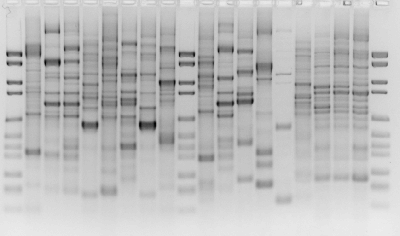Activity
2 - Answers to Assessment Tools (For Instructors)
IDENTIFICATION OF PHI X 174 RF DNA BY RESTRICTION MAPPING

1.
A restriction map shows the location of restriction enzyme recognition sites
on a particular piece of DNA. Because each DNA sequence is unique, the position
of recognition sites is also unique. A match between experimental restriction
banding patterns on a gel and the pattern predicted by the restriction map
positively identifies the DNA.
2. A recognition sequence is a short (usually 4 to 6 nucleotides) palindromic
sequence where a particular restriction enzyme binds and cuts double stranded
DNA.

(Image from www.bio.ic.ac.uk/research/rhac/coutts.htm, 2003)
3.
The banding pattern will change. We used 0.7% to give optimum separation between
bands.
4. Criteria should include buffer compatibility, and clear banding patterns
on the gel. Students will probably find that enzymes that do not cut more
than twice work best. Predicted fragments should not be too large or small
(they should fall on the linear part of the standard curve).
(You could also point out that it is best to avoid enzymes that are inhibited
by DNA methylation. Enzymes should not be prone to star activity (see the
rebase web site). In the real world, price would also be a limiting factor.)
5. The experimental banding patterns/DNA fragment sizes should have matched
the predicted pattern/fragment sizes. If they did not, see the troubleshooting
tips.
6. Doing a double digest increases confidence for DNA identification purposes.
Only a double digest can show the relative position of recognition sites for
two different enzymes. The chance that a particular single-enzyme banding
pattern is produced with two different DNAs is surprisingly large. The chance
that the same double-enzyme banding pattern is produced with two different
DNAs is much, much smaller.
7. The single digests provided additional fragment length data. But more importantly,
single digests serve as positive controls, to make sure both enzymes are working
properly. If either enzyme is not working properly, the double digest results
cannot be trusted.